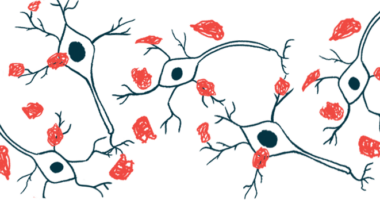PSAP protein may protect nerve cells in Parkinson’s, study shows
Lack of prosaposin protein linked to worse motor symptoms in mice

Levels of the protein prosaposin, known as PSAP, are altered in the brains of people with Parkinson’s disease, and these changes are linked to worse motor symptoms, a study discovered.
Mice lacking PSAP were more susceptible to the loss of nerve cells seen in Parkinson’s patients. Treatment with the prosaposin protein in mice and rats reversed many of the disease’s signs and symptoms, the data showed.
According to researchers, PSAP may be a factor in the development of Parkinson’s, and increasing its levels may slow or even stop disease progression.
“PSAP is a potential modifier of [disease development] of [Parkinson’s disease] and its replenishment may be beneficial in halting [Parkinson’s disease] progression,” the scientists wrote.
The study, “Prosaposin maintains lipid homeostasis in dopamine neurons and counteracts experimental parkinsonism in rodents,” was published in the journal Nature Communications.
Investigating the role of prosaposin protein, or PSAP, in Parkinson’s
Parkinson’s disease is a progressive disorder featuring the loss of dopaminergic neurons, which are the nerve cells that produce the signaling molecule dopamine. The loss of these neurons occurs in an area of the brain called the substantia nigra, and result in the onset of motor symptoms and numerous nonmotor symptoms.
The protein prosaposin, or PSAP, serves as the precursor of saposins (A-D), which are components of enzymes that break down sphingolipids. These fat-like lipids are primarily located in the nervous system and make up the membrane of many cell types.
Because PSAP has been found at lower levels in dopaminergic neurons derived from Parkinson’s patients, scientists in Sweden designed a study to further investigate the protein’s role in the neurodegenerative disorder.
In post-mortem tissue from Parkinson’s patients, PSAP was significantly reduced in dopaminergic neurons in the substantia nigra — a brain region particularly affected in Parkinson’s — compared with unaffected control samples. The team noted that progranulin (PGRN), a protein that facilitates PSAP’s movement within cells and is associated with other brain disorders, was unchanged.
Elevated PSAP levels in the bloodstream and the cerebrospinal fluid (CSF) — a colorless liquid that flows in and around the brain and spinal cord — were tied to worse motor symptoms, as assessed by the Unified Parkinson’s Disease Rating Scale (UPDRS) part 3.
Although no relationship was found between PSAP and nonmotor symptoms, there was a significant correlation between these symptoms and PGRN in the bloodstream and CSF.
Next, researchers created a mouse model that lacked the gene that encodes for PSAP in dopaminergic neurons. These mice had behavioral impairments, reduced levels of markers for dopaminergic neurons, and defects in synaptic plasticity — the ability of synapses, the junctions between two nerve cells that allow them to communicate, to strengthen or weaken over time.
Throughout the brains of PSAP-deleted mice, there was a reduction in sphingolipids alongside the buildup of highly unsaturated and shortened lipids.
PSAP levels found to be altered in Parkinson’s
Further experiments suggested that a lack of PSAP led to the dysfunction of lysosomes, the cell’s recycling centers where prosaposin is located. Also, the observed lipid alterations did not appear to be a downstream consequence of dopaminergic neuronal loss.
Emerging evidence indicates that lipids play a role in the clumping of alpha-synuclein protein, thought to be a factor in the death of dopaminergic neurons. Particularly, unsaturated fatty acids have been shown to increase alpha-synuclein toxicity.
Dopaminergic neurons in mice lacking PSAP showed increased vulnerability to alpha-synuclein overproduction compared with healthy mice. In comparison, overproducing PSAP in these mice reversed toxic alpha-synuclein buildup to levels seen in normal mice.
Overproduction of PSAP in healthy mice, six weeks before exposure to 6-hydroxydopamine (6-OHDA) — a chemical used in this study that’s selectively toxic to dopaminergic neurons — also protected the nerve cells from degeneration.
Finally, rats were treated with PSAP via encapsulated cell biodelivery to the substantia nigra, which is a means of delivering therapeutic agents to targeted areas of the brain. Data showed that this strategy protected against dopaminergic loss induced by alpha-synuclein.
Rats without PSAP delivery had alpha-synuclein-induced slow movements, similar to bradykinesia, or slowness or difficulty in body movement seen in Parkinon’s patients. Meanwhile, the rats treated with PSAP displayed intact body movements.
“Our experiments demonstrate that PSAP levels are altered in [Parkinson’s disease] patients reflecting motor symptoms,” the researchers concluded, noting, as such, that replenishing the prosaposin levels may help in stopping disease progression.








